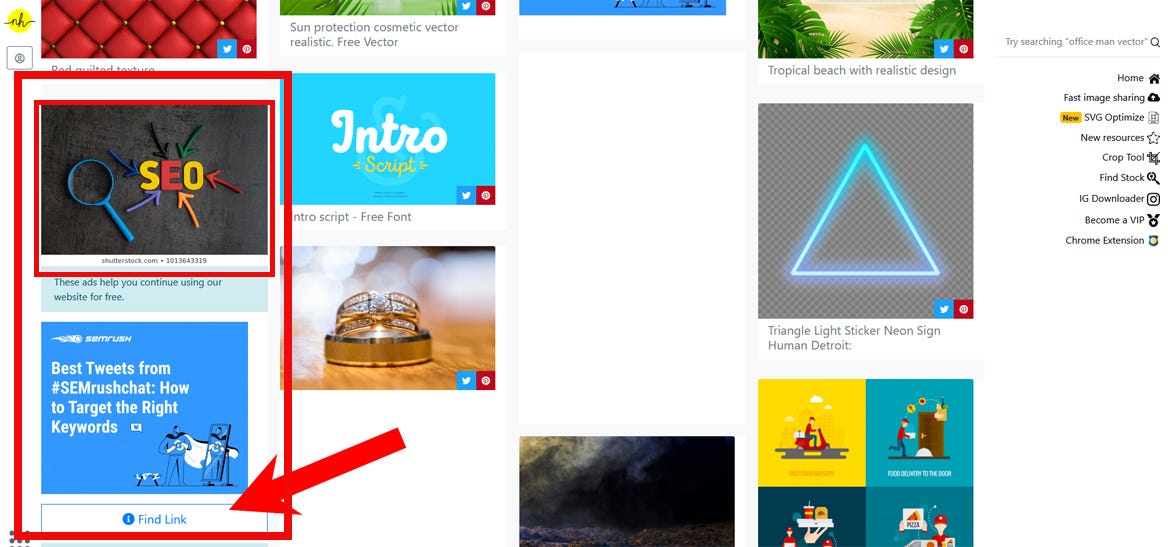Hey there! If you’re looking to spice up your blog with eye-catching images, Shutterstock can be a fantastic resource. While it’s known for its extensive library of premium images, did you know there are ways to access some Shutterstock images for free? Using high-quality visuals not only makes your content more engaging but also helps convey your message more effectively. Whether you’re a beginner blogger or a seasoned content creator, understanding how to legally and effectively use
Understanding Shutterstock’s Licensing Options and Free Resources

Before you start downloading images, it’s important to understand the different licensing options Shutterstock provides. They primarily offer two types of licenses:
- Standard License: This covers most typical uses like blog posts, websites, social media, and presentations. It allows you to use images for commercial purposes, but there are limits on the number of copies or views.
- Enhanced License: For more extensive use, such as merchandise, print runs over 500,000 copies, or large-scale advertising campaigns, this license offers more flexibility and higher usage rights.
Now, you might be wondering, “Are there any free options?” Yes, there are! Shutterstock offers free resources that you can tap into:
- Free Image of the Week: Every week, Shutterstock features a free download of a high-quality image. You just need to create a free account to access these images.
- Free Trial Accounts: Shutterstock often provides free trials with a limited number of downloads. This is perfect if you need images for a specific project or just want to try out their library.
- Creative Commons and Public Domain Resources: While Shutterstock primarily offers licensed images, they also curate collections that are free to use, especially for educational or non-commercial purposes. Always double-check the licensing details!
Remember, even when using free images, it’s crucial to respect the licensing terms. For example, some images may require attribution or have restrictions on commercial use. Always read the license carefully before publishing. By understanding these options, you can confidently enhance your blog with stunning visuals without overspending or risking copyright issues.
How to Find Free Shutterstock Images for Your Blog
So, you’re on the hunt for high-quality images to spice up your blog without breaking the bank. Shutterstock is known for its vast library of stunning visuals, but most of them are paid. Luckily, there are ways to find free Shutterstock images that can give your content a professional touch without costing you a dime.
First things first, it’s important to know that Shutterstock does offer some free images through their official channels. Here’s how you can access them:
- Shutterstock Free Trial: If you’re new to Shutterstock, you might want to take advantage of their free trial. This typically includes a certain number of free downloads that you can use legally for your blog.
- Shutterstock Free Image Collection: Shutterstock periodically offers a selection of free images for download. These are usually highlighted on their homepage or under a dedicated ‘Free Images’ section.
- Official Shutterstock Blog and Resources: Sometimes, Shutterstock releases free images for promotional purposes or special events. Keep an eye on their official blog or social media channels for such offers.
In addition to Shutterstock’s official options, you can also explore third-party websites that curate free images, including some that partner with Shutterstock or host images compatible with Shutterstock licensing. Always verify the licensing to ensure you can legally use the images on your blog.
When searching for free Shutterstock images, use specific keywords related to your blog post topic. For example, if you’re writing about healthy recipes, search terms like healthy food, fresh vegetables, or delicious meals will help narrow down your options. Also, filter your search by selecting the ‘Free’ filter if available, to streamline your search process.
Remember, even if an image is free, proper attribution is often appreciated and sometimes legally required. Check the licensing details before downloading to make sure you’re compliant and giving credit where it’s due.
Step-by-Step Guide to Downloading Free Shutterstock Images
Ready to get those perfect images onto your blog? Here’s a simple step-by-step process to download free Shutterstock images legally and easily:
- Visit the Official Shutterstock Website: Head over to shutterstock.com. If you don’t have an account, creating one is free and quick.
- Search for Your Desired Images: Use the search bar at the top and enter keywords related to your blog topic. Use filters to narrow your results, especially selecting the ‘Free’ option if available.
- Browse and Select Images: Scroll through the options and pick images that best fit your content. Click on an image to view it in detail and check licensing information.
- Check Licensing and Usage Rights: Ensure the image is marked as free or included in a free collection. Read the licensing details—most free images are for personal and commercial use, but it’s good to double-check.
- Click the Download Button: Once you’re satisfied, click the download button. You might be prompted to choose a resolution; select the appropriate size for your blog (usually smaller sizes are sufficient for web use).
- Save the Image to Your Computer: Choose a folder on your device where you want to store the image. Rename the file if needed for easy management.
- Give Proper Attribution: If the license requires attribution, make sure to include the photographer’s name or Shutterstock credit in your blog post.
And that’s it! With these simple steps, you can enrich your blog with beautiful, free Shutterstock images without any hassle. Remember, always respect licensing terms to keep your content legal and ethical. Happy blogging!
Tips for Choosing the Right Images for Your Blog Content
Picking the perfect images for your blog isn’t just about making things look pretty—it’s about enhancing your message and engaging your readers. Here are some friendly tips to help you select images that truly complement your content:
- Align with Your Blog’s Theme: Make sure the images match the overall tone and topic of your post. If you’re writing about healthy eating, choose vibrant, fresh food images. For tech topics, sleek and modern visuals work best.
- Consider Your Audience: Think about what your readers would find appealing or relatable. If your audience is young and trendy, opt for vibrant, lively images. For a professional audience, cleaner and more polished visuals are better.
- Use High-Quality Images: Even free images should be sharp and clear. Blurry or pixelated images can make your blog look unprofessional. Shutterstock’s free options often meet this standard, so pick the best quality you can find.
- Keep It Relevant: The images should support and enhance your content, not distract from it. For example, if you’re discussing productivity tips, images of people working efficiently are perfect.
- Balance Text and Visuals: Don’t overcrowd your blog with images. Use them strategically—perhaps one or two well-chosen images per section—to keep your layout clean and reader-friendly.
Remember, images are there to tell a story and evoke emotion. Take your time to choose visuals that resonate with your message and make your blog more inviting and engaging.
Legal Considerations When Using Free Shutterstock Images
While Shutterstock offers a treasure trove of free images, it’s super important to understand the legal side of things. Using images incorrectly can lead to copyright issues or legal trouble, which nobody wants. Here’s what you need to keep in mind:
- Always Check the License: Even for free images, Shutterstock provides specific licensing terms. Make sure you read and understand whether the image is free for commercial use, editorial purposes, or if attribution is required.
- Respect Usage Rights: Some free images might be limited to personal projects or non-profit use. If you’re monetizing your blog or using images for commercial purposes, double-check that the license covers this.
- Avoid Copyright Infringement: Never assume an image is free to use without proper attribution or license confirmation. If in doubt, look for images explicitly labeled as free for commercial use or consider purchasing a license.
- Provide Attribution When Needed: Certain free images require you to credit the creator. A simple “Image by [Photographer’s Name] from Shutterstock” is usually enough, and it’s good practice to include this in your captions or footer.
- Keep Records: Save screenshots or links to the images and their licenses. This can be helpful if questions about your image use ever come up.
In a nutshell, always respect the rules attached to free images. Doing so not only keeps you on the right side of the law but also supports the creators who contribute their work for free. Using Shutterstock’s free images responsibly ensures your blog stays professional, trustworthy, and legally sound.
Alternative Sources for Free High-Quality Blog Images
While Shutterstock is a fantastic resource for premium images, it’s not the only game in town when it comes to finding high-quality visuals for your blog—especially if you’re on a budget or looking for free options. Luckily, there are several reputable websites where you can find stunning, high-resolution images without spending a dime.
Here are some of the top alternatives:
- Pexels: Known for its vast library of free stock photos, Pexels offers a wide variety of images that are perfect for bloggers. All photos are licensed under Creative Commons Zero (CC0), meaning you can use them freely without attribution.
- Unsplash: A favorite among bloggers and designers alike, Unsplash provides beautiful, high-resolution images contributed by talented photographers worldwide. The platform’s licensing allows for free use, including commercial projects.
- Pixabay: Not only does Pixabay host photos, but it also offers illustrations, vectors, and videos. Its extensive collection makes it easy to find visuals that match your blog’s tone and style.
- Canva: While primarily a design tool, Canva also offers a library of free images you can use in your blog graphics. It’s particularly handy if you want to create custom visuals or infographics.
- Freepik: Offers a mix of free and premium images, vectors, and illustrations. Be sure to check the licensing for each image, as some may require attribution.
When using these sources, always double-check the licensing terms. Most of these sites offer images under CC0 or similar licenses, meaning you can use them for personal or commercial blogs without attribution. However, some images might have restrictions, especially if they feature recognizable people or trademarks.
Another tip is to search for specific keywords related to your blog topic, but also experiment with different search terms to uncover hidden gems. And don’t forget to customize images—adding filters, cropping, or overlaying text can help make free images uniquely yours.
Conclusion and Best Practices for Using Shutterstock Images on Your Blog
Now that you know how to access free images and explore alternative sources, let’s wrap up with some key takeaways and best practices for using Shutterstock images effectively on your blog.
Conclusion: Shutterstock is an excellent resource for high-quality, professional images that can elevate your blog’s visual appeal. While it’s a paid service, you can access a wealth of images through subscriptions, licenses, or free trials. However, always respect licensing agreements and copyright laws to avoid any legal issues.
Best Practices:
- Always check the license: Whether you’re using Shutterstock or alternative sources, ensure you understand the licensing terms. This includes whether attribution is required and if images can be used commercially.
- Use images relevant to your content: Select visuals that complement and enhance your blog’s message. Irrelevant or stocky-looking images can detract from your credibility.
- Optimize image size and quality: Compress images for faster page loading without sacrificing quality. Use appropriate dimensions—large enough to look good but not so big that they slow down your site.
- Maintain a consistent style: Develop a visual style or theme that aligns with your brand. This creates a cohesive and professional look across your blog.
- Attribute when necessary: If an image requires attribution, make sure to give proper credit in a visible location, such as at the end of your blog post.
- Mix and match sources: Don’t rely solely on Shutterstock. Incorporate images from free sources to diversify your visuals and reduce costs.
- Respect copyright and privacy: Avoid using images that may infringe on someone’s privacy or feature recognizable individuals without consent.
In the end, the goal is to use compelling images that enhance your storytelling and engage your readers. By following these best practices, you’ll ensure your blog remains professional, ethical, and visually appealing—even when relying on free or alternative image sources.


